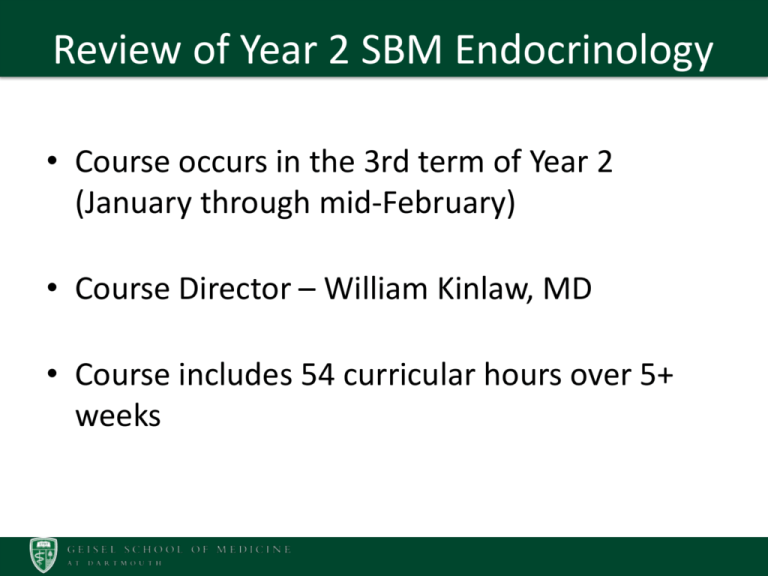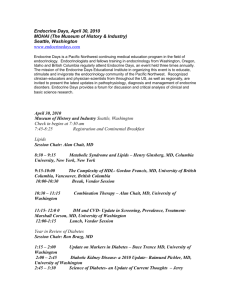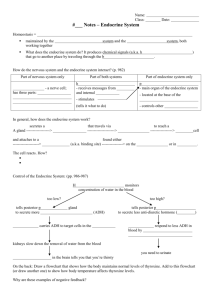SBM Endocrinology Course Review
advertisement

Review of Year 2 SBM Endocrinology • Course occurs in the 3rd term of Year 2 (January through mid-February) • Course Director – William Kinlaw, MD • Course includes 54 curricular hours over 5+ weeks Course Objectives – Content Review There are 25 course objectives that fulfill (old) Geisel competencies* as follows: • 20 address specific knowledge in the preclinical domain, and seem appropriate • 1 addresses clinical skills • 2 address communication skills • 2 address components of professionalism • 2 address personal improvement • 4 address systems-based practice * Course objectives have been mapped to new Geisel competencies since the time of this review Course Objectives – Content Review 1. Review and describe the structure and function of endocrine organs and the general principles of feedback control and homeostasis. 2. Define terms common to the discussion of patients with disorders of the endocrine system (especially diabetes mellitus, and abnormalities of pituitary, thyroid, adrenal and parathyroid glands) and review basic principles. 3. Correlate symptoms and signs with specific hormonal imbalances and receptor dysfunctions (including insulin, growth hormone, thyroid hormones, parathyroid hormones, and adrenal hormones). 4. Explain the approach to evaluating the cause of specific hormonal excesses of deficiency states. 5. Explain the complications that can arise from various endocrine abnormalities. 6. Describe the epidemiology, risk factors and associations for developing specific endocrine disorders. 7. Discuss the role, utility and significance of diagnostic testing (e.g., blood and imaging) in patients with endocrine disorders. 8. Explain the basis for pharmacological and non-pharmacological interventions in the management of common endocrine diseases. 9. Describe the pathophysiology, and major pathologic features as well as the epidemiology of various pathological processes including neoplasms, inflammation, autoimmunity, and vasculopathy/angiopathy. 10.Explain the levels of evidence in determining effective and cost-effective care and the limitations of each. 11.Utilize the results of outcome studies to evaluate the effectiveness of patient care. 12.Describe how operations and processes that occur within a complex healthcare system have an impact on cost and quality of effective and timely care of the patient with endocrine disorders. Course Objectives – Content Review (continued) 13. 14. 15. 16. 17. 18. 19. 20. 21. 22. 23. 24. 25. Practice and demonstrate systematic problem-solving skills with regard to patients with endocrine disease. Communicate with fellow students and faculty about patients with endocrine disease. Demonstrate team skills by participating effectively in team exercises. Take responsibility for his- or her-own medical education. Search efficiently for and obtain recent, high quality, relevant medical information and scientific literature to solve problems. Read critically, evaluate, and assess medical information and scientific literature about important endocrine topics and questions. Explain the nutritional aspects of fad diets Demonstrate the methods for teaching dietary principles and demonstrate how to take a dietary history Explain common dietary programs for diabetes Demonstrate evaluation of food labels, especially carbs and fat List important micronutrients and likely deficiencies of micronutrients Explain dietary therapy for lipid lowering therapy and diabetes nutrition To meet professional responsibilities fully, including being punctual, present, and engaged in meetings and other activities, and being reliable in commitments to tasks. Course Objectives – Content Review • Course objectives are provided in the syllabus • Objectives are written in the correct format (describe what students should be able to “do” at the end of the course) • Course objectives were reviewed and correlated with NBME Step 1 brochure and Society for Endocrinology (UK specialty society) suggested curriculum for medical students – All major content areas are addressed by the course or by other Geisel courses Session Objectives • Session objectives are provided for most sessions either in the session powerpoint or the syllabus handout • Most are written in the correct format (stating what students should be able to “do” at the end of the session) – A few use language such as “know” or “understand” – Some are listed in handout, but not in powerpoint Session Objectives • Each session objective maps to a course objective – The majority of session objectives relate to course objectives 1-9 • Areas of unplanned redundancy seem few and expected – Searched: diabetes, obesity, osteoporosis, thyroid – Some expected overlap with year 1 physiology, metabolism, SBM FEK, SBM Reproduction – Obesity as a broad topic could benefit from better coordination among courses Summary regarding Objectives • Objectives appear to be well-aligned with NBME and specialty society recommended curricula • Additional coordination of coverage of obesity/appetite/weight control across the curriculum is needed • Faculty teaching material that overlaps with other courses should be sure to coordinate with one another • Faculty should ensure that session objectives are written in appropriate format and included as second slide of their PowerPoint files Course Learning Opportunities • Lecture 25 hrs. (46%) • Patient presentations 5 hrs. (9%) • Conferences 19 hrs. (35%) • Laboratory 4 hrs. (7%) • Large group discussion 2 hrs. (4%) Course Learning Opportunities • Small group conferences are a highlight of the course and are highly rated by students • Students have asked for answer keys to the small group problem sets to be handed out – Faculty feel that this is not necessary since each question is discussed in detail in the small groups – Faculty are concerned that having answer keys available to students before the small groups (handed down from students in prior years) would decrease the educational value of students working through problem sets on their own • Students would like to receive narrative feedback from small group leaders Summary regarding Pedagogy • Small groups are a strength of this course with students rating both faculty and educational value highly – Ensuring that each small group covers essential material is important • Lecture sessions dominate the large group course hours • Lectures are highly rated overall, but some are criticized for being too detailed Assessment • Students must pass both: – Final exam • multiple choice plus short answer questions – Participation portion of the course • Attendance and participation at 9 small group sessions (18 points) • Attendance at patient presentation large group sessions (3 points) • 3 non-graded practice quizzes are offered Assessment – Final Exam • 18 multiple choice questions worth 2 points each – Mean on multiple choice section was 69% in 2014-2015, with several students answering only 50% of questions correctly • 7 short answer question sets, each worth from 2-12 points (total of 57 points) – Mean on short answer section was 86% in 2014-2015 – Students request sample short-answer questions • Overall mean for exam was 81% in 2014-2015, with a broader than typical standard deviation of 7.5 Assessment – Final Exam • Students felt that topics were not represented on final exam in a manner proportionate to their coverage in the course • Students were concerned that small details were tested in multiple choice questions, rather than larger concepts • Students felt that practice quizzes did not match difficulty level of final exam • Students strongly requested practice questions for the short answer portion of the exam Assessment- Participation • Students receive points for attendance and participation in small group conferences and attendance at patient sessions – Nearly all students received full credit – Students would like narrative feedback to be provided by small group leaders since they usually work with the same leader over 19 instructional hours Summary regarding Assessment • Final exam was seen as difficult and detailed, not representative of course content, and challenging to prepare for – Providing a breakdown of topic areas for exam prior to exam may help (e.g. X% of questions on diabetes, X% on hyperlipidemia, etc.) • Recommend modifying multiple choice questions to align them as much as possible with USMLE-level expectations • Recommend providing a few practice question sets to help students prepare for the short answer portion • Recommend that small group leaders provide narrative feedback to students Measures of Quality – Step I Geisel USMLE Step 1 Scores (SD above National Mean) 2012* 2013* 2014* Behavioral Sciences .52 .25 .15 Cardiovascular System .45 .5 .02 Gastrointestinal System .57 .6 .52 Hematopoietic/lymph systems .55 .18 .1 Immune System .3 .5 .16 Nervous System and Behavioral Health N/a N/a .08 Renal/Urinary System .45 .22 .25 Reproductive/Endocrine System* .50 .40 N/a Reproductive System* N/a N/a .42 Endocrine System* N/a N/a .42 Respiratory System .53 .37 .18 * Prior to 2014, combined scores were reported for Reproductive/Endocrine Systems Measures of Quality – Course Reviews scale [1=poor; 2=fair; 3=good; 4=very good; 5=excellent] SBM Endocrinology 2014-2015 Year 2 mean 2014-2015 Clarity of learning objectives 3.93 4.05 Congruence of exam to learning objectives 3.08 3.84 Effectiveness of organization of course 3.91 4.01 Overall quality of course 4.09 4.15 Mean large group instructor effectiveness 4.15 4.21 Mean small group leader effectiveness 4.77 4.47 Measures of Quality – Course Reviews Lectures and Handouts • Positive Comments (12) – – – – Pathology well taught and integrated (2) Detailed final exam review (2) Lectures short, concise, and to the point (1) End-of-lecture questions (1) • Criticisms (6) – Many board-relevant topics omitted (1) – Obesity lecture not coordinated with other course (1) – Hyperlipidemia (2), type 1 diabetes (1), obesity (1) too detail-oriented Measures of Quality – Course Reviews Lectures and Handouts • Suggestions for improvement (10) – Provide more clearly and consistently defined expectations (4)- specifically level of detail students need to know – Organize lectures and notes in a succinct and consistent way (3) • Suggestions: case-based, clinical presentation/diagnostic algorithms/treatment – Improve coordination of diabetes material (2) – Encourage lecturers to post learning objectives on second PowerPoint slide (1) – Final review: minimize side conversations by students, utilize clickers, minimize disagreements between professors (1) Measures of Quality – Course Reviews Final Exam • Positive Comments (2) – Appreciated open-ended questions (1) – Liked that practice questions were provided (1) • Criticisms (23) – Final exam too detail-focused, not representative of what was emphasized in class (12) • Too great of a focus on lipid disorders (3) • Pathology (3), type 1 diabetes (2), thyroid (1) underrepresented – Use of open ended questions (7) • Some questions were vague (3) – Multiple choice questions not in board-style format (2) – Normal values not always given (1) Measures of Quality – Course Reviews Final Exam • Suggestions for improvement (19) – Broaden scope of final exam and ensure proportional representation of material (12) – Switch to multiple choice questions (4) – Provide more practice questions (2) • Change practice questions to “choose one answer” type questions (1) Measures of Quality – Course Reviews Small Group • Positive Comments (55) – – – – Material was well integrated with lectures (24) Helpful to reinforce material and facilitate learning (6) Plentiful, covered every major topic (4) Time to digest material between lecture and small group (4) – Puts material in clinical context, encourages critical thinking (4) – Liked having to involve others (1) – Journal articles provided useful exposure to basic science and primary literature (1) Measures of Quality – Course Reviews Small Group • Criticisms (6) – – – – Covered too much information outside of lecture (2) Journal articles were not very valuable (2) Some students were unprepared (1) Didn’t cover all information (1) • Suggestions for improvement (18) – Answer keys should be provided (13) – Cases should be updated and/or edited (4) – Provide better paper for Diabetic Complications small group (1) Measures of Quality – Course Reviews Patient Presentations • Positive Comments (33) – – – – Patient presentations very high quality (23) Useful for understanding material and patient perspective (8) Panhypopituitarism patient (7) Helped explore culturally competent care (2) • Criticisms (6) – Not enough diversity (5) – Hyperthyroid patient appeared uninterested (1) • Suggestions for improvement (3) – Consider using video conferences (1) – Make sure that students are coming in on time and not using electronic devices (1) – Focus more on patient’s experience, fewer faculty interruptions (1) Measures of Quality – Course Reviews Overall Organization/Structure • Positive Comments (5) • Criticisms (7) – – – – Course disorganized (3) Calcium part of the course too rushed (1) Trouble delineating primary vs. secondary disease (1) No lecture on basic hormone axis (1) • Suggestions for improvement – – – – Consider providing condensed version of all course topics (1) Consider adding in-hospital component (1) Improve coordination between faculty discussing the same hormone axis (1) Post small group assignments directly onto Canvas (1) Measures of Quality – Course Reviews Diversity/Cultural Competency • Positive Comments (12) • Criticisms (9) – Conflation of race and socioeconomic status (2) • Suggestions for improvement – Update terminology (hermaphroditism, cretinism) (3) – Provide greater exploration of culturally competent care (1) Summary of Student Comments • • • • Student Comments Broaden scope of final exam and ensure proportional representation of material Consider providing answer keys for small groups Work to update outdated terminology and cases (hermaphroditism, cretinism) Consider further improvement in consistency between lectures Summary regarding Measures of Quality • Small groups are highly rated by students • Students perform very well on Endocrinology topics on USMLE Step 1 Summary of Recommendations • Objectives – Ensure handouts and PowerPoints are updated and include session objectives • General Course Content – Work to update outdated terminology and cases – Recommend MEC consider facilitating a coordinated approach to topic of obesity/appetite/weight control across the curriculum • Small Groups – Provide more explicit discussion guide for small group leaders (and ensure students are aware this is happening) – Consider providing “key points” to students for small groups – Provide narrative feedback to students from small group leaders • Final exam – Revise final exam multiple choice questions to align with course content (with topics represented in proportion to their coverage in the course) and USMLE question style – Provide students with breakdown of topic areas prior to exam – Consider providing sample short answer questions prior to final exam SBM Endocrinology- looking forward Challenge: • Integrate two new faculty, accommodate upcoming faculty retirements • Maintain large time commitment to small groups in the face of clinical pressure Responses to critiques: • Compile “take home messages” from small groups • Revise some outdated terminology • Improve the final examination (especially the MCQs) • Participate in a pan-SBM review of obesity coverage (Cardiol, GI, Psych), focus primarily on endocrine causes and insulin resistance




